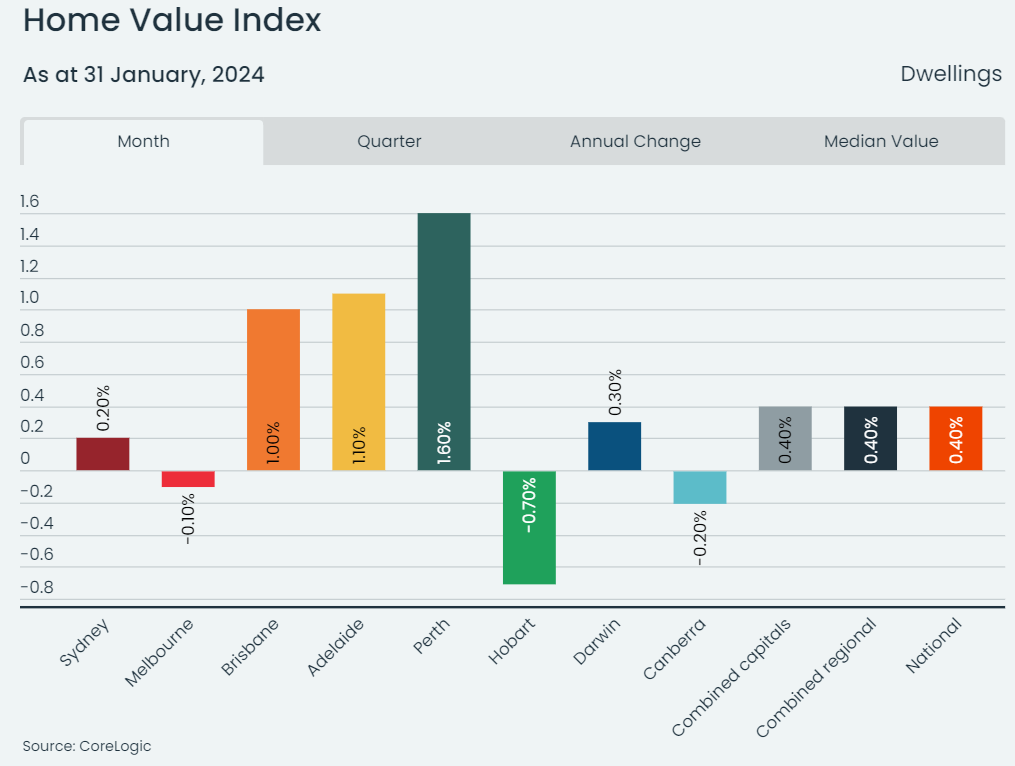

Australia’s robust housing market has continued its upward trajectory into 2024, with CoreLogic’s national Home Value Index (HVI) reporting a 0.4% increase in January.
This marks the 12th consecutive month of value rises, surpassing the 0.3% increases seen in November and December.
Despite the headline growth, housing market performance varied across the country. While Melbourne (-0.1%), Hobart (-0.7%), and Canberra (-0.2%) experienced subtle declines, Perth, Adelaide, and Brisbane recorded monthly increases of 1% or more.
Tim Lawless (pictured above), CoreLogic’s research director, identified Perth as a standout, noting its persistent rapid rate of capital gains.
“Perth home values rose a further 1.6% in January, on par with the city’s growth trend in November and December and only slightly lower than the recent high of 1.8% recorded in October,” Lawless said.
“The western capital continues to see housing demand outweigh supply, helping to push values 16.7% higher over the past 12 months. Despite that, housing prices remain relatively affordable compared with most capital cities, with the median dwelling value sitting just under $677,000.”
Despite this growth, he said housing prices in Perth remain relatively affordable, with the median dwelling value just under $677,000.

The HVI also revealed that house values outpaced unit values in January, with the median capital city house-unit gap reaching a record high of 45.2%. Detached housing values rose by 0.5%, adding around $4,800 to the median house value, while unit values increased by 0.1%, equivalent to a $900 lift.
Lawless pointed out the trend of Australians showing a willingness to pay a higher premium for detached homes, with capital city house values surging 11% higher since the upswing began compared to a 6.9% increase in unit values.
Regional markets are exhibiting stronger value growth compared to capital cities, with the combined regional index rising 1.2% over the rolling quarter, outpacing the combined capitals index, which rose by 1%.
“While both the combined capitals and combined regional markets are losing momentum in the pace of value growth, the capital city trend has slowed more sharply, mostly due to the flattening of growth conditions in Melbourne and Sydney,” Lawless said.
“Across the other states, regional WA, SA and Queensland continue to record a slower pace of growth relative to their capital city counterparts; these are also the three regional markets where dwelling values are at record highs.”
Despite concerns about housing affordability, the volume of home sales remained slightly above average in the past three months. CoreLogic estimated that 115,241 dwellings were sold in the three months to January, marking a 11.9% increase from the same period last year and 0.5% above the previous five-year average for this time of the year.
“Despite ongoing cost-of-living pressures, high interest rates, low consumer sentiment and affordability constraints, homes are still selling,” Lawless said. “Housing demand has been buoyed by high migration, but also tight rental markets that have probably incentivised renters to transition towards homeownership if they can afford to do so.”
For more details, download the January HVI.
Get the hottest and freshest mortgage news delivered right into your inbox. Subscribe now to our FREE daily newsletter.
